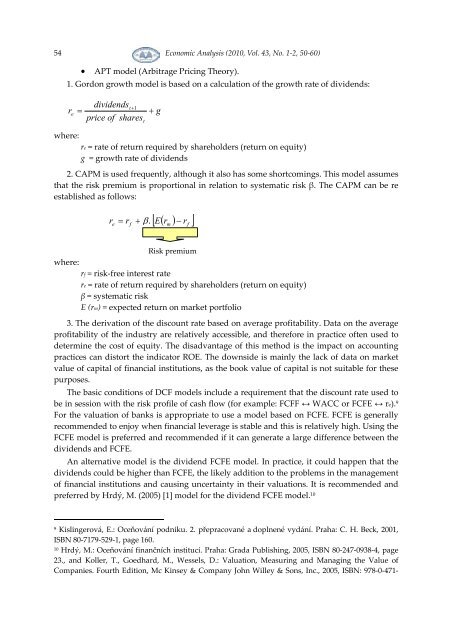Twice a Year Scientific Journal
Twice a Year Scientific Journal
Twice a Year Scientific Journal
Create successful ePaper yourself
Turn your PDF publications into a flip-book with our unique Google optimized e-Paper software.
54<br />
Economic Analysis (2010, Vol. 43, No. 1-2, 50-60)<br />
• APT model (Arbitrage Pricing Theory).<br />
1. Gordon growth model is based on a calculation of the growth rate of dividends:<br />
r<br />
where:<br />
dividends<br />
t+1<br />
e<br />
=<br />
+<br />
price of<br />
shares<br />
t<br />
g<br />
re = rate of return required by shareholders (return on equity)<br />
g = growth rate of dividends<br />
2. CAPM is used frequently, although it also has some shortcomings. This model assumes<br />
that the risk premium is proportional in relation to systematic risk β. The CAPM can be re<br />
established as follows:<br />
r<br />
e<br />
= r + β .<br />
f<br />
[ E( r ) − r ]<br />
m<br />
f<br />
where:<br />
Risk premium<br />
rf = risk-free interest rate<br />
re = rate of return required by shareholders (return on equity)<br />
β = systematic risk<br />
E (rm) = expected return on market portfolio<br />
3. The derivation of the discount rate based on average profitability. Data on the average<br />
profitability of the industry are relatively accessible, and therefore in practice often used to<br />
determine the cost of equity. The disadvantage of this method is the impact on accounting<br />
practices can distort the indicator ROE. The downside is mainly the lack of data on market<br />
value of capital of financial institutions, as the book value of capital is not suitable for these<br />
purposes.<br />
The basic conditions of DCF models include a requirement that the discount rate used to<br />
be in session with the risk profile of cash flow (for example: FCFF ↔ WACC or FCFE ↔ re). 9<br />
For the valuation of banks is appropriate to use a model based on FCFE. FCFE is generally<br />
recommended to enjoy when financial leverage is stable and this is relatively high. Using the<br />
FCFE model is preferred and recommended if it can generate a large difference between the<br />
dividends and FCFE.<br />
An alternative model is the dividend FCFE model. In practice, it could happen that the<br />
dividends could be higher than FCFE, the likely addition to the problems in the management<br />
of financial institutions and causing uncertainty in their valuations. It is recommended and<br />
preferred by Hrdý, M. (2005) [1] model for the dividend FCFE model. 10<br />
9<br />
Kislingerová, E.: Oceňování podniku. 2. přepracované a doplnené vydání. Praha: C. H. Beck, 2001,<br />
ISBN 80-7179-529-1, page 160.<br />
10<br />
Hrdý, M.: Oceňování finančních institucí. Praha: Grada Publishing, 2005, ISBN 80-247-0938-4, page<br />
23., and Koller, T., Goedhard, M., Wessels, D.: Valuation, Measuring and Managing the Value of<br />
Companies. Fourth Edition, Mc Kinsey & Company John Willey & Sons, Inc., 2005, ISBN: 978-0-471-
















